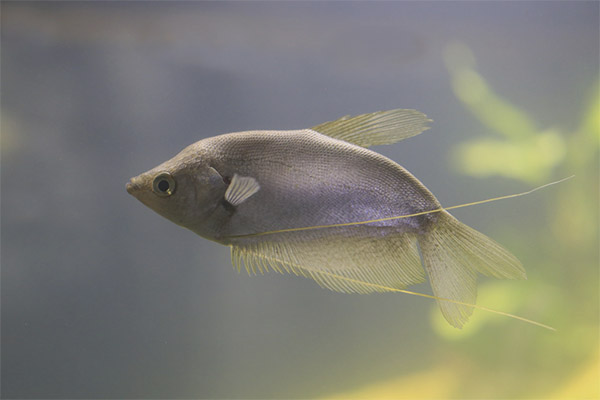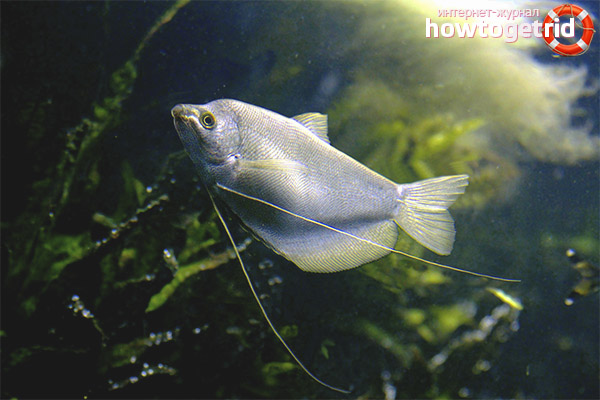The content of the article
Lunar Gourami belongs to the family Osphronemus. This fish has a magnificent and elegant look, even in spite of the fact that it does not have a bright color. However, the distinctive ability of Lunar Gourami from other types of aquarium fish lies in the fact that its scales are capable of reflecting even a very weak and dim light. Due to this, around the Moon Gurami creates the effect of the glow of white-moon color.
Natural habitat
For the first time, Lunar Gurami was found in Southeast Asia. Today, this species can be found outside of its natural habitat. For example, quite often, many wild populations of this fish can be found even in countries that are located in South America.
In the natural habitat of the Lunar Gourami, as a rule, is found on the flat part of the marshy water bodies.Also, this species can be found in freshwater lakes, in the floodplains of the river called the Mekong, as well as in swamps. Lunar Gourami, as a halo for its habitat, prefers ponds with shallow depth, as well as still water and heavily overgrown shore.
Being in its natural habitat, Lunar Gourami prefers zooplankton as its main food. Also, this fish often hunts for small crustaceans or insects that live in the pond. One of the distinguishing features of this fish is also the fact that it is capable of catching small insects that live above the surface of the water. During the catching of surface insects, the Lunar Gourami, due to the sharp reduction of cavities located in the mouth, sharply throws out a small stream of water, which, when it enters the insect, knocks it into the reservoir.
general description
In addition, this species of fish has long filiform pectoral fins.The color of the body of this fish has a silvery shade. However, with age, a shade of green begins to appear clearly in the area of the spinal section of the Lunar Gurami. The color of the iris can be red or orange. It is worth noting that the fins of the males also have a shade of either red or orange color, while at the females the fins, as a rule, have a light yellow color or they may be completely colorless.
Nutrition
In the home conditions Lunar Gourami does not neglect any food that is intended for feeding aquarium fish. However, it should be noted that, if necessary, you can purchase a special feed intended for feeding. In such a special food, which is designed for this aquarium fish, contains all the necessary trace elements and vitamin complexes that stimulate its growth and development.
In order to make a variety in the diet of the Lunar Gourami, you can use animal feed. For example, in the daily diet of this aquarium fish you can include insects such as:
- pipemaker;
- Cyclops;
- bloodworm.
In addition, as a variety, Lunar Ghurami periodically can also be given food of plant origin. For example, once in several days this fish can be fed with finely chopped lettuce or spinach. It should be noted that such finely chopped plants like spinach or lettuce can be added to animal feed and combined to feed them aquarium fish several times a day, depending on the diet.
Conditions of detention and rules of care in the aquarium

Proper maintenance of the Lunar Gourami involves the use of an aquarium with a volume of at least 150 liters for 1 pair of these fish. Also, the correct content of this type involves the use of a special filter to clean the water in the aquarium. Such a filter should have a high level of performance and at the same time not create a strong movement in the water. This is due to the fact that the Moon Gurami prefers to be in calm, stagnant water, and the appearance of a strong current in the aquarium can provoke a stressful situation. Despite the fact that this species of fish prefers ponds with low oxygen content, yet the aquarium in which they are kept must be equipped with an aeration system.Such a system of aeration should saturate the water in the aquarium with oxygen around the clock.
In the event that the fish moves closer to the surface of the water and begins to actively swallow the air, this indicates a low content of oxygen in the aquarium. The lack of oxygen in the water can be caused both by a weak aeration system and by the accumulation of excessive amounts of organic waste in the aquarium. Therefore, it is recommended to change 25% of the water contained in the aquarium in which the Lunar Gourami are located, every 7 days. In this case, the water temperature should be from 25 to 30 degrees Celsius.
During the decoration of the aquarium, which contains the Moon Gourami, you should try to achieve a balance between the availability of free areas for free swimming and places with thickets of plants. It should be noted that this type of aquarium fish tends to damage plants. At registration of an aquarium it is recommended to apply the hard-leaved plants possessing strong root system. Alternatively, artificial plants can be used to decorate the aquarium.
Social behavior
Under conditions of aquarium breeding and keeping, Lunar Gourami can successfully live both in a group and in a pair. It should be noted that in the case of the content of the group of this aquarium fish, which consists of more than 3 individuals, a large volume aquarium is necessary. In addition, in such an aquarium there should be many shelters due to the fact that the males of the Lunar Gourami are prone to the manifestation of territorial behavior. As a result, in a small aquarium in which there are no shelters, weak fish will be constantly attacked by their stronger relatives.
The females of the Lunar Gurami are more tolerant, unlike the males. The most optimal ratio of the content of this species of fish in the aquarium will be the presence of several females per male. In one aquarium, the Lunar Gourami get along excellently with the peace-loving and calm, as well as large species of fish.
Gender Differences
Males have a more graceful and slim appearance. Their fins are orange in color. However, at the beginning of the spawning period, the fins of the males of this aquarium fish acquire a red hue.In addition, in the lunar goura males, the fins located in the region of the back and the anus have a pointed shape.
Breeding
In order to stimulate the spawning of lunar gourami in an aquarium, it is necessary to lower the water level to about 20 cm. Also, to stimulate its spawning, the fish should be transferred to an enhanced diet of animal feed. In such conditions, the female will gradually begin to appear caviar, because of what she begins to swell. The fins of the male in this period acquire a red hue.
After laying the roe, fry begin to appear from it already on day 2. They need to be transferred to another aquarium, away from adults who can eat them. For feeding the young Lunar Gourami, you should use a special micro-feed or daphnia.
Video: aquarium fish lunar gourami












To send